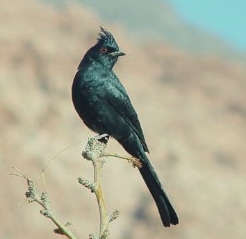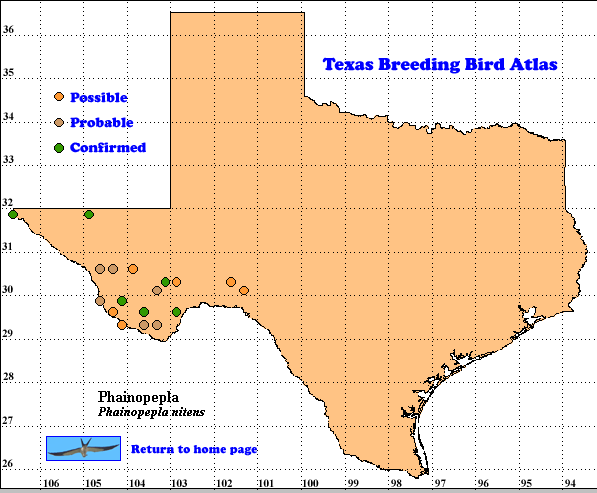Phainopeplas constitute one of 4 species of Silky-flycatchers, a family whose other 3 members are resident further south in Middle America. The Gray Silky-flycatcher (Ptulogonys cinereus) of Mexico and Guatemala is an accidental in south and west Texas. (Am. Ornithol. Union 1998, Lockwood and Freeman 2004),
Although Phainopeplas do catch flying insects which come near their exposed perches, much of their diet consists of mistletoe berries in the lower-elevation deserts of Arizona and California and berries of shrubs and junipers in higher elevation woodlands (Chu and Walsberg 1999).
Authors such as Monson and Phillips (1981) have pondered the presence of two breeding ranges in Arizona, which differ in elevation, vegetation and breding season. One explanation, movement of low-elevation breeders to higher habitats to produce a second brood, is summarized by Chu and Walsberg (1999). There is no experimental evidence to support this hypothesis. A second possibility is that the populations at different elevations are different genetically, either at the species or subspecies level, as is the case with Curve-billed Thrashers (Toxostoma curvirostre) whose Sonoran and Chihuahuan desert populations have been shown to be genetically distinct (Rojas-Soto et al. 2007).
DISTRIBUTION. During the 1987-1992 field work seasons of the TBBA project, researchers found confirmed breeding evidence for Phainopeplas in 6 blocks, probable in 8 blocks and possible in 9 blocks, all in the Trans-Pecos or along the Pecos River (see the region map in Lockwood and Freeman [2004]). North American Breeding Bird Survey (BBS) data indicate a relative abundance in Texas of <1 Phainopepla per 40 km (25 mi) route. Texas is at the eastern end of the United States breeding range which extends to northern California with the highest relative abundances of 10-30 found in southern Arizona. Relative abundances similar to those in Texas are found in New Mexico, southern Nevada and southwest Utah (Sauer et al. 2008). The breeding range continues south through Baja California, Sonora and the central plateau of Mexico south to the Isthmus of Tehuantepec (Howell and Webb 1995).
SEASONAL OCCURRENCE Phainopeplas are year-round residents of the Trans-Pecos and the lower Pecos River valley. They breed from April to June (Oberholser 1974). In Arizona atlasers found breeding evidence from March into July (Wise-Gervais 2005).
BREEDING HABITAT. Phainopeplas breed in Texas from about 400 m (1500 ft) to 1880 m (5500 ft) in shrubby, wooded and riparian areas such as the foothills of the Davis and Del Norte mountains (Oberholser 1974, Lockwood and Freeman 2004). In Arizona 67% of blocks with breeding evidence were in Sonoran desert habitats, both riparian and non-riparian. Breeding was also observed at elevations, as high as 1930 m (6845 ft) in habitats such as pinyon-juniper and evergreen oaks (Wise-Gervais 2005).
Within these habitat types males build nests, during courtship, in horizontal or vertical forks of trees like mesquite, catclaw acacia, hackberry, cottonwood, willow or sycamore and shrubs or mistletoe clumps. Nests contain plant stems, blossoms, leaves and cottony fibers, bound with spider silk and thinly lined with down and animal hair. The nests have an outside diameter of 9.5-11.5 cm (3.8-4.5 in), height of 3.8-6.4 cm (1.5-2.5 in), inside diameter 6.4 cm (2.5 in) and cup depth 2.5-3.8 cm (1-1.5 in; Harrison 1979, Chu and Walsberg. 1999).
In these structures females usually lay 2-3 gray or grayish-white eggs, covered with purple or black dos. Incubation lasts 14 days with the two sexes sharing the task almost equally. Nestlings usually remain in the nest for 20 days after hatching and stay with their parents for at least another week (Harrison 1979, Chu and Walsberg. 1999).
STATUS. Lockwood and Freeman (2004) describe Phainopeplas as rare to locally uncommon in the Trans-Pecos region. The similarity of the distribution of summer and breeding symbols on the map in Oberholser (1974) to the TBBA map below suggests no appreciable change in distribution has taken place in recent years. BBS data for the Trans-Pecos derived from 9 routes, recording an average of less than one Phainopepla per route, are not adequate to produce a biologically meaningful trend. Data from 124 routes across the United States produce a statistically significant annual population change of -2.4% for the period 1980-2007. Since this trend is derived primarily from Arizona and California data (Sauer et al. 2008), it may not apply to Texas birds. Text by Robert C. Tweit (2009)
Wise-Gervais, C. 2005. Phainopepla (Phainopepla nitens). In Arizona breeding bird atlas. pp. 458-459 (T. E. Corman and C. Wise-Gervais, eds.). University of New Mexico Press, Albuquerque.

